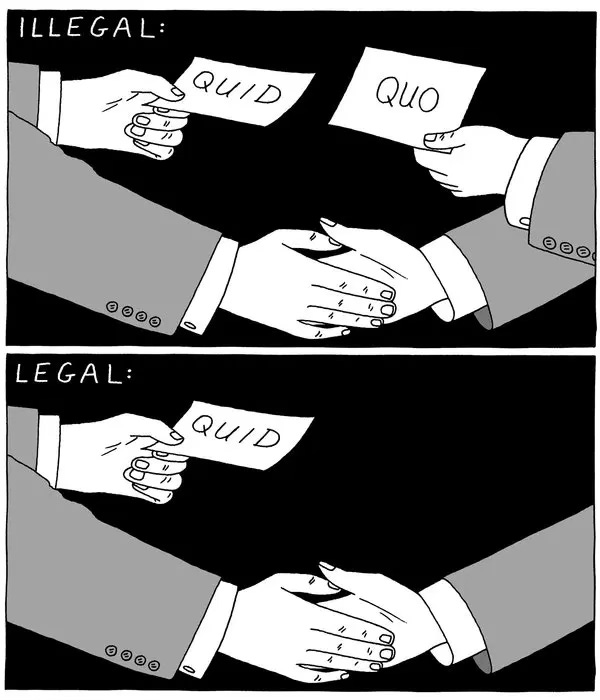Last week, Ann Telnaes resigned from her position as editorial cartoonist for the Washington Post when one of her cartoons, a rough draft illustration showing a handful of tech billionaires, including Sam Altman and Jeff Bezos, in a recumbent position before the towering figure of our about-to-be-sworn-in next president, was rejected by the editorial board at the paper.
In her follow up Substack post, the cartoonist justified her decision to resign from a long stint as a key WaPo staffer of their “Editorial Cartoons” section as a kind of freedom of the press protest, characterizing the Post’s decision as “a game changer…and dangerous for a free press.”
But according to the Post, the decision to reject the cartoon was based strictly as an editorial matter regarding what they claim is a “bias against repetition.” Apparently, the Post had reached its quota of cartoons depicting genuflecting oligarchs and Telnaes’s polemical drawing of a spineless capitalist class before a would-be tyrant was passed over, not to honor any political fealties, but merely to maintain the quality control of the paper’s editorial standards.
As one might expect, the brouhaha is being reported in the mainstream press as a First Amendment issue. The Bezos owned Washington Post seems now within the crosshairs previously occupied by Elon Musk and his X platform as the new bête noire of anxious liberals eager to challenge the tech overlord regime—using the oligarchs’ own free speech weaponry against them. Perhaps the maverick exertions of newly minted populist stars like Musk and their hemming and hawing about free speech, so the liberal narrative goes, is really just a matter of which speech serves the interests of the arriving Trump administration.
But the problem with this narrative is that it mistakes its priors and thereby glosses over a key component within the power dynamics between the capitalist and political classes. The mistake that Telnaes’s cartoon makes is a matter of role reversal: in depicting a team of billionaires prostrate in front of a looming Trump the cartoonist seems to be placing a high degree of faith in the capitalist class’s willingness to manage authentic political relations.
But since when have capitalists ever concerned themselves with such sincerity? After all, isn’t it the politicians who do their bidding and not the other way around?
And since when should we, the citizenry, feel so enamored with capitalists that we should wish to empower them with autonomous displays of power?
The idea which the mainstream media would have us believe from this story, that it is the responsibility of billionaire tech oligarchs to maintain complete autonomy from the powers of the state, belies liberals’ so-called progressive bonafides and reveals their enthusiasm for the free market fundamentalism they claim to be against. As with most matters Trumpian, liberals are more than willing to abandon their most avowed principles, if only it can guarantee them rhetorical points in their unending war against the rise of Trump. They take the “she protesteth too much” to embarrassing levels.
The real hypocrisy within the power dynamics between the capitalist class and the political class—which Telnaes’s cartoon wanted to depict but, hamstrung by anti-Trump hysteria, could in fact not accomplish—is wholly on the Trump side of the equation. It may be said of Musk’s eleventh hour hat throw-in on the MAGA movement’s rise to power that without it Trump would never have won.
Such counterfactuals, however disprovable, nonetheless point to the conspicuous alliance which much of Big Tech has fostered with the incoming Trump administration. This includes not only long-standing amigos like Peter Thiel but newcomers like David Sacks and other crypto barons who have jumped on the MAGA train like goldbugs out West in the late 19th century.
At best, this alliance raises giant red flags for the true believers of populism within the ranks, such as Steve Bannon and Stephen Miller. At worst, it constitutes a liquidation of the protectionist and supposedly worker-led MAGA movement. It seems like a more accurate cartoon would have put Trump in the recumbent position and the oligarchs as occupiers of the Graeco-Roman statuary pedestal.
The fact of the matter is that if there is anything conspicuous about the capitalist class it isn’t that they are insufficiently autonomous but that they are autonomous to begin with. A relationship between the capitalist and the political classes that reflects a more humane common good for the average American would be constituted by a much more diminished role in politics on the part of the owners of the means of production. But anyone who has spent more than five seconds looking at American governance dynamics can tell you that this is not in fact the way things are in “the land of the free and the home of the brave.”
That this cartoon proposes a universe in which a figure like Trump exerts the kind of imperious will depicted in its rough draft illustration is truly laughable. That’s because the common denominator within our incendiary polarized political conversation is the very neat and assured position of the highest bidders who, through our system of legalized bribery, pay their way into positions of extreme power.
Liberals may continue to go on crowing about how Trump is some Hitler or Stalin with total control of the American political conversation, and most likely they will, until their throats are bleeding, but that will not change this most durable of American privileges. MAGA might seem like some sort of populist takeover but it—like its political enemies among the progressives and liberals—too, has a price.




To be honest I thought the cartoon was a bit, well, obvious...and as you have so perspicaciously observed Carlos, inaccurate too.